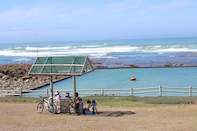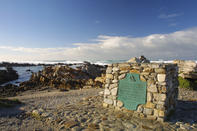A Picturesque Little Bay
Little more than a collection of fisherman’s cottages, Struis Bay is located around a picturesque little bay, dotted with small sailing vessels bobbing in the sea. The houses are loosely arranged around the harbour, and tourist facilities are limited.

A campsite, a couple of coffee shops and a general dealer are about all you’ll find here. Do note, however, that there is not much else after Struis Bay and very few facilities at Cape Agulhas, so you’d better get what you need while you are in town.
The road from Struis Bay to Cape Agulhas is great. Humble cottages line one side of the road and, on the other side, the coastline is a jumble of green grass, ochre rocks and brooding sea. After a few k’s, the cottages stop and the iconic, candy-striped lighthouse of Cape Agulhas looms large on top of a small rise. The lighthouse can be toured, and also contains a museum. Once past the lighthouse, keep following the signs for Cape Agulhas. This will lead you to a parking area and, from here, it’s a short walk to the Southern-most point of mainland Africa.
Although it is not as obviously dramatic as Cape Point, Cape Agulhas has a low-key power all its own and it’s a very rewarding destination for any traveller to reach.
Austere Beauty of Cape Agulhas
When you step out of the car, you will be struck by the austere beauty of the scene, compared to the hyperbolical grandeur of Cape Point. There are no mountains here, no curio shops, no restaurants and no grand walkways. Nevertheless, Cape Agulhas seems to resonate with the weight of the continent balanced on its shoulders. Turn your back to the land, and you are surrounded by sea and clouds and gulls and noisy silence. Turn away from the ocean, and you can imagine that you are gazing up the entire bulk of Africa, all the way to Cairo.
To emphasise the point, a concrete plinth has been erected which indicates your position at the end of the Earth, and the cartographic separation between Indian and Atlantic Ocean has been clearly signposted. Originally called L’Agulhas, this part of the coast was named after the Portuguese word for ‘Needle’. This name probably refers to a compass needle, which points due South, with no deviation East or West, from this headland.
But is Cape Agulhas really the southernmost point of Africa? Well, almost. Strictly speaking, the small South African territory of Marion Island in the Antarctic Ocean is the Southern-most African landmass, but you would have to be a real stickler to deny Cape Agulhas its claim on the title. In my mind, this lonely, empty peninsula is the perfect culmination for the African continent, and the oceans seem to roar with approbation.
By David Fleminger

 The seaside beauty of Cape Agulhas and Struis Bay (or Struisbaai) can be experienced in many ways. This corner of South Africa is known for ...
The seaside beauty of Cape Agulhas and Struis Bay (or Struisbaai) can be experienced in many ways. This corner of South Africa is known for ... Cape Agulhas is the southernmost point of Africa, and the official meeting point of the cold Atlantic and warm Indian Oceans. Also known as ...
Cape Agulhas is the southernmost point of Africa, and the official meeting point of the cold Atlantic and warm Indian Oceans. Also known as ...